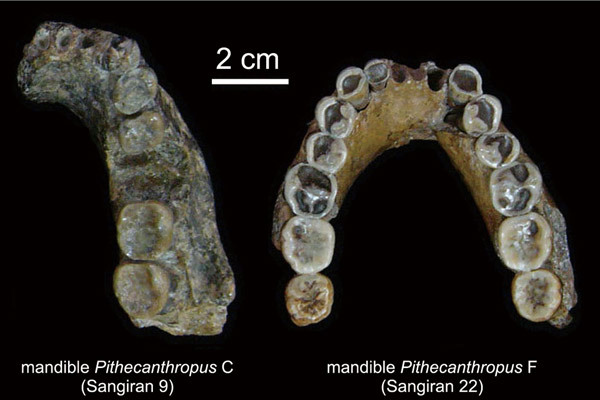- Investigation: Homo sapiens did not cause the extinction of Neanderthals
- Dating: The last Homo erectus survived until 108,000 years ago in Java
In 1891, a Dutch anatomist named Eugène Dubois discovered the skull and femur of a strange creature while exploring the banks of the Solo river in Java (Indonesia). Halfway between ape and human being, the bones indicated that it was a being that walked upright , so Dubois - convinced of having found the 'missing link' between men and monkeys - baptized his finding as Anthropopithecus erectus (literally man- erect monkey).
Actually, he was best known by the international press and public as the 'Java Man'. The age of these remains has been dated between 700,000 and one million years, and today we know that they correspond to the first specimen of Homo erectus discovered. Since then, other fossils of this species have been unearthed in Asia and Africa, where the species first appeared almost two million years ago.
Pioneers among the hominid family, they were the first to have a body proportion similar to that of modern Homo sapiens , in addition to the first, probably, to cook food and the first to leave the African continent, beginning a journey of hundreds of thousands of years that would take them to the Caucasus, China and Indonesia.
The erectus inhabited more than one million years on two continents, but survived in Java longer than anywhere else: the last remains found, also on the banks of the Solo River, date back 108,000 years .
In the 30s of the 20th century, another European scientist, the German GHR von Koenigswald, found in Java another fundamental piece in the puzzle of evolution: the Sangiran cave . Its vault contained an impressive loot of fossils of Homo erectus from different eras, among which were the oldest human remains found in Southeast Asia. Sangiran has since been one of the most important places to understand the evolution of our ancestors and their first migrations, although the exact chronology of the site remains controversial.
Now, a new analysis published Thursday in Science has concluded that the arrival of the first hominids in this cave occurred between 1.3 and 1.5 million years ago, almost 300,000 years later than it was. I believed A team of Japanese researchers has used a combination of dating by two different methods: fission marks and Uranium-lead.
The use of two techniques has allowed us to determine with greater precision the age of the zircons - volcanic minerals - that surround the sediments in which the fossils were found. "It is not a unique dating, but a chronological framework for all geological layers," explains Professor Boris Brasseur, a researcher at the University of Picardie-Jules Verne, in France, and author of a comment on the subject in The same number of Science .
To date, more than 100 copies of three different subspecies have been recovered among the sediments in the cave. "German, Japanese, American and French teams have been studying Sangiran for the past 80 years , and part of their work has been to calculate the age of volcanic minerals," the researcher adds. This allows determining the maximum and minimum age of the remains trapped in each stratum, "but the dates obtained have sometimes been contradictory," Brasseur acknowledges.
"This new, more reliable dating significantly rejuvenates (between 300,000 and 500,000 years) the age of the layers with older hominid fossils, which, on the other hand, is consistent with other results obtained by paleomagnetism."
The first great migration
The precise definition of Sangiran's chronology is crucial to understand both the history of the first migrations in Asia and the local evolution of hominids in Java . The new date indicates that the arrival of H. erectus to Indonesia came much later than its passage through the deposits of Dmanisi (Georgia) and Riwat (Pakistan), which would trace a route from the Sinai Peninsula to the Chinese province from Yunnan, then continue south.
The first erectus populations to settle there would later be affected by new waves, which would be more numerous once the global climate was changing. " We know that the global climate underwent a great change a million years ago , with a great phase of cooling some 900,000 years ago," explains Shuji Matsu'ura, a researcher at the Ibaraki Natural Museum in Japan. "That phase is the first time, during the Pleistocene, that the sea level dropped 120 meters below the current one and exposed the Sonda platform, around the Indonesian archipelago, forming a large land mass."
On the other hand, among the maremágnum of fossils in the vault of the cave there are several subspecies of H. erectus that lived different periods, perhaps the result of different migratory waves . Researchers are still trying to discover which species lived together and which ones replaced others. "Fossils cataloged as Homo erectus have high anatomical diversity, so much so that it would sometimes justify the creation of new names," Brasseur explains, "and some of these species appear to have coexisted in the same ecosystem."
According to the criteria of The Trust Project
Know more- science
- Science and Health
Climate crisis Pedro Sánchez: "Al Gore has favorably valued the Energy and Climate Plan"
Climate crisis Harrison Ford revolutionizes the Madrid Climate Summit: 'Trump has no courage'
PaleontologyDinosaurs with feathers already had lice problems

